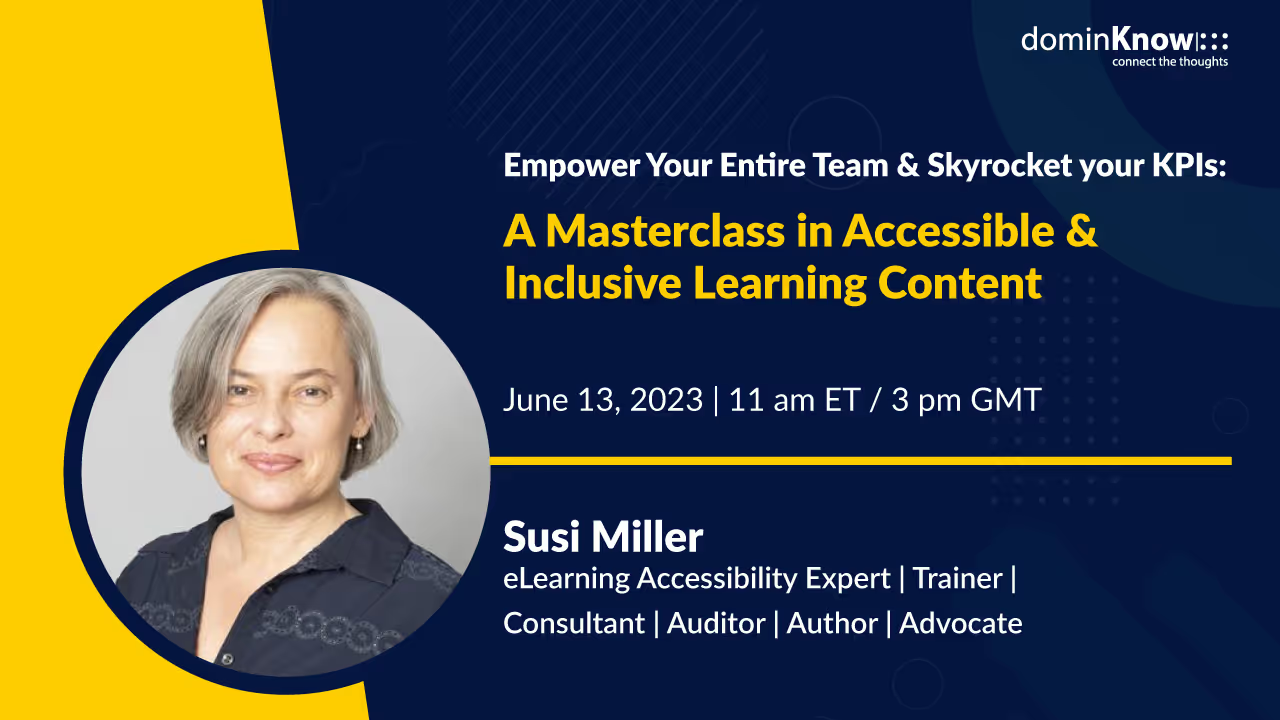What is the difference between accessible and inclusive learning content?



As part of our upcoming Masterclass in Accessible and Inclusive Learning Content on June 13 at 11 am ET, we’ve asked our guest, Susi Miller to share her thoughts in a two-part blog. This is part one of two blogs.
What is the difference between accessible and inclusive learning content?
When I wrote my book Designing Accessible Learning Content, I was very aware that I still had a lot to learn. I’ve therefore been extremely lucky that since it was published, I’ve had the immense privilege of providing eLearning accessibility training, consultancy and auditing support to over 50 organisations throughout the private, public and voluntary sectors. And this is where the real learning has taken place. This unique experience has given me the opportunity to find out first-hand about the key challenges that organisations are facing. A common issue I’ve come across is confusion about how to make learning content both accessible and inclusive. Because, although the two concepts are closely related, they are not the same thing. But why does it matter, and how can we make sure we’re getting it right?
What is accessible learning content?
Let’s begin with a focus on accessibility. According to W3C (The World Wide Web Consortium), accessibility is about creating digital content that allows people with different disabilities and access needs to “equally perceive, understand, navigate, and interact with content” and to “contribute equally without barriers.” For me, this is a great summary of what we should try to achieve with accessible learning content. So, how can we make sure that our learning allows people with disabilities and access needs to have an equal experience to everyone else?
The most widely acknowledged way that practitioners and organisations can make their learning content accessible is to follow legal accessibility guidelines. Although many different standards exist, it is the Web Content Accessibility Guidelines (WCAG), created and maintained by W3C, that are considered to be the “single shared standard for web content accessibility that meets the needs of individuals, organizations, and governments internationally.” Meeting these standards for learning content is a legal obligation for many organisations, particularly those in the federal or public sector. However, it is increasingly becoming a best-practice requirement for all organisations, especially for those who want to legitimize their commitment to Equity, Diversity, and Inclusion.
How do I create accessible learning content?
For the majority of organisations, creating legally accessible learning content means satisfying the conditions of the 50 WCAG Version 2.1 Level A and AA standards. These are considered to be the “basic” and “intermediate” levels to meet. Some organisations also aspire to comply with the “advanced” AAA standards although W3C concedes that “it is not possible to satisfy all Level AAA criteria for some content.” It’s also worth being aware that the WCAG Version 2.2 standards are due to be released in the Summer of 2023. In their current format, this adds another nine requirements to be aware of, although several of these impact authoring tool providers rather than learning practitioners.
I’ve learnt in my consultancy work that the sheer number of standards which need to be met is one of the major barriers which can prevent organisations and practitioners from getting on board with accessibility. It isn’t possible to look in detail at all the guidelines in this article (this is what I cover in my book), but I’ll focus instead on just four of them to give an idea of what this means in practice. I’ve chosen the following standards because they each address one of the four digital access needs; vision, hearing, motor and cognitive. I’ve also focused on these examples because they very often feature in the accessibility audits of learning content, we carry out at eLaHub.
Vision
1.4.1 Use of Color - Level A / 1.4.11 Non-text Contrast - Level AA
Make sure the colour of the text and the background it appears on meets the contrast ratio of at least 4.5:1 for normal text, and at least 3:1 for large text. Also, make sure the colour contrast ratio between graphical objects or interactive items and the background they appear on meets the contrast ratio of at least 3:1.
Hearing
1.2.2 Captions (Prerecorded) - Level A
Provide captions for all pre-recorded videos with sound. To provide an equivalent experience and to meet the WCAG standard, make sure that captions are:
- Synchronised to the action in the video
- Descriptive - i.e., they contain important sound effects, who is speaking, and emotions conveyed by a tone of voice which someone who is deaf or hard of hearing may miss
- Accurate - i.e., they have punctuation and don’t contain errors.
Motor
2.1.1 Keyboard - Level A
Avoid interactions which can’t be completed by learners who use a keyboard or other related assistive technology. Drag-and-drop interactions are common examples in learning content, although they can be made accessible with certain tools. Another alternative to avoiding these interactions completely is to provide an accessible alternative version for them.
Cognitive
2.2.2 Pause, Stop, Hide - Level A
Make sure that any moving content you include in your learning can be controlled so that it doesn’t distract people who have cognitive access needs. This standard technically applies only to content which starts automatically, lasts for longer than five seconds and appears alongside other content, but it’s worth considering for all moving elements.
These are just a few of the many guidelines to be aware of. But even if we meet every one of the WCAG standards, it doesn’t mean that our learning content is inclusive. So let’s find out about the difference between the two.
What is inclusive learning content?
Although accessibility is a vital part of inclusive learning – it’s only one aspect. Inclusive learning recognises people’s entitlement to a learning experience that respects diversity, enables participation and considers a variety of learning needs and preferences. My definition is that “it is learning that provides a welcoming, engaging, and enjoyable experience for everyone. It is learning where no one feels excluded or has a lesser experience than anyone else.” In its broadest sense inclusive learning encompasses all aspects of diversity including race and ethnicity, gender, sexual orientation, age, socio-economic status etc. Because our focus in this article is on people with disabilities and access needs, I’ll concentrate on a few key actions we can take to make sure they feel welcomed and considered in the learning experience.
How do I create inclusive learning content?
None of the following recommendations are standards that need to be met for the Web Content Accessibility Guidelines. Yet they all have an impact on improving the inclusivity of content for learners who are disabled or have access needs. Again, these four examples often feature in our audits.
Provide an accessibility statement for your learning resources
Adding an accessibility statement and contact information is a legal requirement for many organisations. But even if it isn’t, it’s still a great way to show that you are committed to accessibility and are doing your best to consider everyone’s access needs.
Use inclusive language
Using inclusive instructions like select instead of click or enter instead of type that don’t make any assumptions about how people interact with content is another great way to make everyone feel included.
AVOID USING TEXT ALL IN CAPITAL LETTERS
According to GOV.UK, using text in all caps makes it between 13-18% more difficult for learners to read. It can also be particularly challenging for some people with dyslexia.
Use inclusive imagery
Use images in your learning content which include every lens of diversity, equity, and inclusion. This includes people with a range of visible disabilities and access needs - not just one token image of a person in a wheelchair that we often see in our audits.
Now that we’ve identified the difference between accessible and inclusive learning content, the next important question to address is why we should be making our learning content both accessible and inclusive. You can find out in my next blog coming soon.
Learn more about accessible and inclusive learning content with Susi Miller on June 13, 2023 at 11 am ET.
Save your spot and register today.

More tips on making content accessible and inclusive
Designing Accessible Learning Content by Susi Miller
Related Resources
.avif)
New to IDIODC?
Instructional Designers in Offices Drinking Coffee (#IDIODC) is a free weekly eLearning video cast and podcast that is Sponsored by dominknow.
Join us live – or later in your favourite app!
Is your training created, managed, and distributed flawlessly? Try dominKnow | ONE
Deliver training/knowledge at the point when people need it with dominKnow | ONE



.svg)






